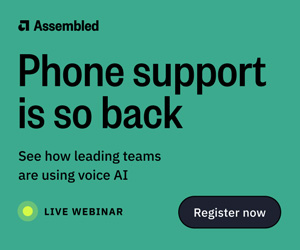Merijn te Booij at Genesys explains the need to prepare your contact centre workforce for the AI revolution.
Listen to almost anyone talk about artificial intelligence (AI), and you’ll likely hear one or two – or 50 – cries of fear that “AI is taking our jobs!” While it’s true that AI is changing how we all work, it has the potential to change it for the better.
In most cases, and especially in the contact centre, AI isn’t replacing employees; it’s enhancing their abilities.
The AI revolution is transforming contact centre roles – making them more engaging, robust and satisfying.
The addition of AI means that simple, rote tasks can be automated to chatbots and voicebots. At the same time, human agents continue to handle the more fulfilling work of orchestrating personalised customer experiences and meeting their customers’ ever-growing expectations.
This future of work is one in which employees and AI tools work in tandem to create exceptional experiences.
The Consistent March of AI Innovation
AI isn’t going anywhere. In fact, it’s only becoming more prevalent in business. According to Forbes Advisor, businesses are using AI throughout several areas, with customer service applications being the most popular.
In the contact centre space, AI helps drive loyalty by creating more personalised customer experiences. AI-enabled workforce engagement management (WEM) tools also have a profound impact on employee productivity and satisfaction.
By automating processes and equipping managers with the actionable insights gleaned from deep analytics, AI boosts employee performance and motivation. For example, AI offers several powerful out-of-the-box capabilities to improve employee engagement.
It helps businesses:
- Better understand employees and customers – and areas for improvement in interactions – through conversational AI that automatically analyses customer-agent conversations for insights.
- Perform data-driven forecasting and planning, leveraging AI-powered automation to streamline the process or resource planning using a single comprehensive tool.
- Spot patterns of excellence and opportunities for improvement through AI-generated insights, enhancing quality assurance by identifying and understanding the root causes behind them.
- Enhance employee performance and reduce turnover by using AI to pinpoint specific knowledge and skill gaps, as well as providing gamification, real-time metrics and personalised goals to improve motivation.
Companies that don’t embrace AI technology will be left behind by those that do. That means your workforce must be ready for it. And all teams need to adapt before the business can truly put AI to work.
Focusing on workforce development, including retraining employees and building trust in technology will help your teams seamlessly adjust to working alongside AI.
Getting AI Right in the Workplace
Preparing the workforce for AI is essential. Here are six key steps for a smoother introduction and adoption.
1. Educate and Prepare the Workforce.
AI is a culture shift. Ensure your employees understand the technology and strive to develop a positive culture of acceptance around it. Build trust in AI by demonstrating how it will improve employees’ work and lives.
2. Coach and Re-Train
Naturally, employees will need to be trained to use new AI tools and processes. AI-powered WEM tools can help supervisors identify areas of employee success, where they need improvement and training opportunities.
3. Promote Lifelong Learning
Give employees access to resources about AI and its use throughout the business and encourage further education on the technology.
Create opportunities within the company for continuous learning and ways to stay up to date on the latest AI trends. AI isn’t a one-and-done implementation: Just as it continues to evolve, so too must your teams.
4. Set Realistic Employee Expectations
Make sure employees understand the reality of how AI will change their jobs and work culture. Studies show that while nearly half of employees are afraid AI will make them redundant, seven in 10 are more than happy to let AI help reduce their workloads.
5. Set Realistic Manager Expectations
Similarly, make sure managers have a clear and realistic idea of what success looks like for their employees and how long it will take to get there. Help them to address employee concerns and encourage experimentation to build confidence.
6. Develop a Strong AI Ethics Framework
As powerful as AI is for creating value, it must be built on an ethical foundation. Create a solid AI ethics policy for the organisation and communicate it to employees.
This will ensure the technology is applied securely and adheres to data standards. It will also make certain that bias in AI models is addressed (and reduced). Be sure employees understand their roles in achieving the organisation’s ethical standards around AI use and protecting data privacy.
From Agents to Knowledge Workers: The Evolution of CX Roles
AI tools provide a wealth of new opportunities for businesses, but there’s still a lot of learning to be done to be sure we get it right for your employees and your customers.
As the contact centre landscape evolves, the roles within it must also evolve. The traditional view of agents as transactional responders is giving way to a more progressive vision of these professionals as knowledge workers.
This shift is driven by the need for more complex problem-solving skills, deeper product knowledge, and the ability to deliver empathic and personalised customer interactions.
Knowledge workers in the CX realm aren’t just answering queries; they’re leveraging data analytics, engaging in customer journey optimization and using advanced technologies to enhance the customer experience.
This evolution requires a new approach to training and development that focuses on critical thinking, advanced communication skills and continuous learning.
Organisations must invest in their employees, transforming them into empowered knowledge workers who can contribute to strategic goals and drive innovation.
By doing so, companies can improve employee satisfaction and retention, leading to better customer outcomes and a stronger competitive edge.
With the rise of AI, not only frontline agents but also supervisors, managers, planners, quality managers, and forecasters need to evolve into knowledge workers.
AI’s introduction elevates their roles, enabling them to leverage advanced analytics, predictive insights and automated processes.
This transformation allows them to make more informed decisions, optimise resource allocation and enhance quality management.
By becoming knowledge workers, these professionals can better support their teams, drive continuous improvement and contribute more strategically to the organisation’s success.
The transition from employees to knowledge workers doesn’t just mean a change in job titles; it’s also a fundamental shift in how we view and value the people who interact with our customers and support first-line workers.
It’s an investment in a future where every customer interaction is an opportunity for excellence and growth.
Evolving Customer Experience Roles: By the Numbers
- 70% of engaged employees indicate they have a good understanding of how to meet customer needs, while only 17% of non-engaged employees say the same.
- Disengaged employees cost $8.8 trillion in productivity worldwide.
- A positive employee experience (EX) creates 16 times more engagement and makes employees eight times more likely to stay at a company.
By focusing on a human-centric approach and leveraging advanced technologies, companies can create an environment where employees are empowered to excel.
This not only enhances the customer experience but also drives continuous business growth, increases brand loyalty, and improves overall profitability.
It’s time to completely rethink your strategy, culture and technology to make this vision a reality — and, ultimately, create the environment your employees (and customers) deserve.
This blog post has been re-published by kind permission of Genesys – View the Original Article
For more information about Genesys - visit the Genesys Website
Call Centre Helper is not responsible for the content of these guest blog posts. The opinions expressed in this article are those of the author, and do not necessarily reflect those of Call Centre Helper.
Author: Genesys
Published On: 1st Aug 2024 - Last modified: 22nd Oct 2024
Read more about - Guest Blogs, Genesys






 Genesys empowers more than 8,000 organisations in over 100 countries to improve loyalty and business outcomes by creating the best experiences for their customers and employees. Through Genesys Cloud, the AI-Powered Experience Orchestration platform, Genesys delivers the future of CX to organisations of all sizes so they can provide empathetic, personalised experience at scale. As the trusted platform that is born in the cloud, Genesys Cloud helps organisations accelerate growth by enabling them to differentiate with the right customer experience at the right time, while driving stronger workforce engagement, efficiency and operational improvements.
Genesys empowers more than 8,000 organisations in over 100 countries to improve loyalty and business outcomes by creating the best experiences for their customers and employees. Through Genesys Cloud, the AI-Powered Experience Orchestration platform, Genesys delivers the future of CX to organisations of all sizes so they can provide empathetic, personalised experience at scale. As the trusted platform that is born in the cloud, Genesys Cloud helps organisations accelerate growth by enabling them to differentiate with the right customer experience at the right time, while driving stronger workforce engagement, efficiency and operational improvements. 






























